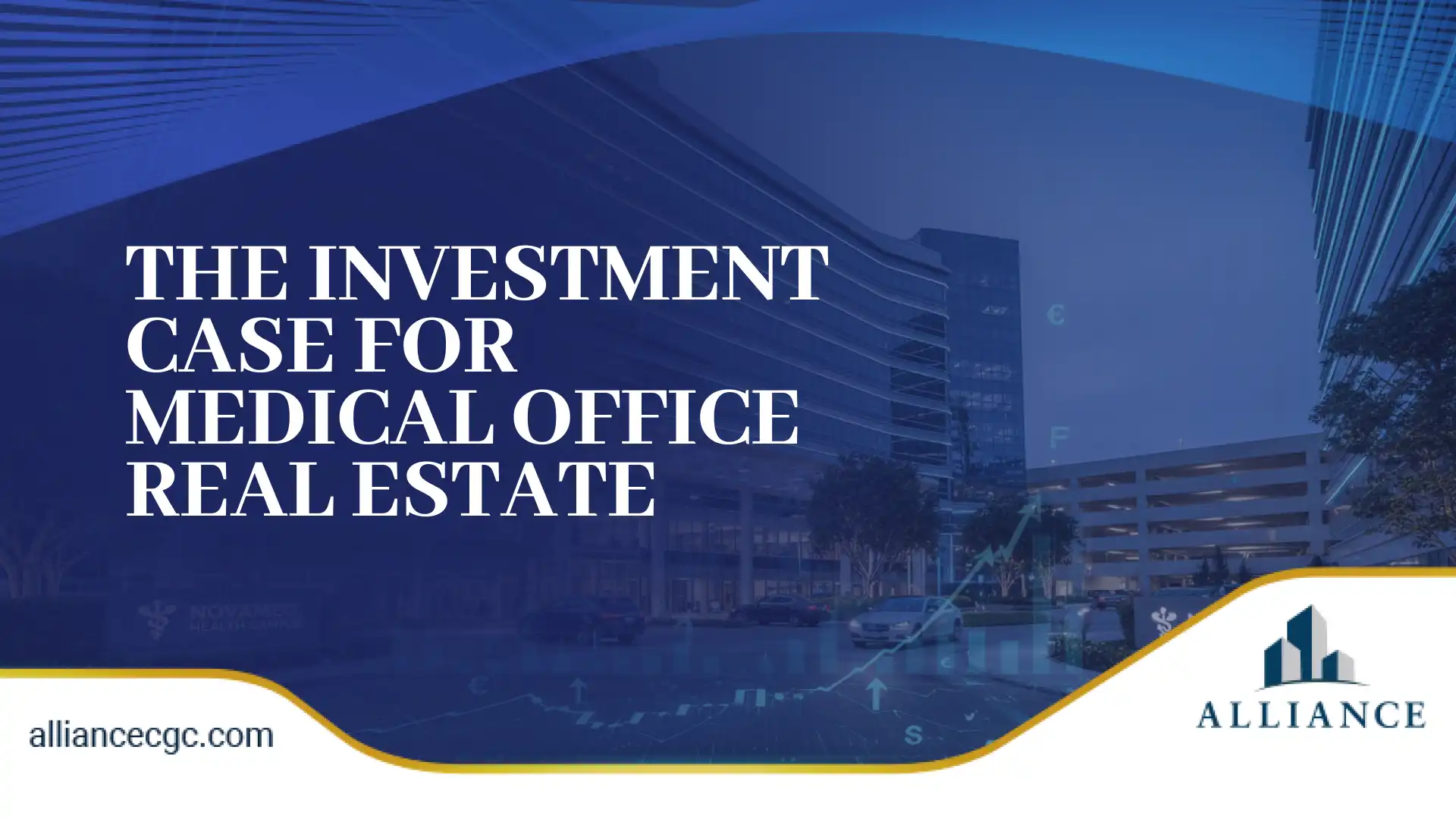Growth in Outpatient Care: How It’s Fueling the Medical Real Estate Boom
July 21, 2025

Outpatient care isn’t just growing, it is redrawing the blueprint of healthcare real estate. As diagnostics and routine treatments exit hospital campuses into nimble, neighborhood clinics, medical real estate is transforming in structure and opportunity.
Hospitals are now channeling complexity, critical care, and inpatient stays while day-to-day services flow into purpose-built outpatient environments. That subtle shift has ignited demand for medical office buildings, ambulatory surgery centers, and hybrid healthcare campuses, assets marked by long-term tenancy, consistent utilization, and operational durability.
A March 2025 MedPAC report highlights this: hospital outpatient services per Medicare beneficiary rose 2.4% from 2022 to 2023, while inpatient volume barely budged. This is not a fad; it's a structural realignment in both where care happens and where capital should be allocated.
Where that momentum flows next could define the winners of the following healthcare investment cycle.
Why Is Outpatient Care on the Rise?

Outpatient care refers to medical procedures, diagnostics, or services that do not require an overnight hospital stay. Over the last decade, healthcare delivery has shifted dramatically in this direction.
Cost Efficiency for Providers and Patients
Hospitals are expensive to operate. Outpatient centers reduce overhead costs for providers and lower bills for patients, especially as more insurers push for site-neutral payments. This makes outpatient facilities attractive to both healthcare systems and private practitioners.
Patient Preferences and Convenience
Patients are opting for convenience. Outpatient centers are typically located closer to residential areas, offer quicker services, and involve fewer logistical challenges than hospital visits. The pandemic further accelerated this trend, with safety and efficiency becoming top priorities.
Technology and Minimally Invasive Procedures
Advancements in medical technology now allow surgeries and treatments that once required hospital admission to be done safely in outpatient settings. This is especially stron in orthopedics, oncology, dermatology, and gastroenterology.
Policy and Reimbursement Changes
CMS (Centers for Medicare & Medicaid Services) has steadily increased the number of procedures approved for outpatient settings and reimbursement. As public and private payers adopt these models, providers have more incentive to shift their operations.
What Types of Facilities Are Seeing Growth?

The outpatient boom isn’t uniform; some care types are seeing explosive growth. These segments are top-of-mind for investors seeking medical office stability:
1. Ambulatory Surgical Centers (ASCs)
ASCs offer same-day surgical care and are growing rapidly. According to the Ambulatory Surgery Center Association, shifting surgeries to ASCs saves Medicare billions annually. These centers are in high demand in suburban markets like Dallas, Tampa, and Charlotte.
2. Diagnostic Imaging and Labs
Diagnostic services like MRIs, CT scans, and blood labs are critical to outpatient treatment. Freestanding imaging centers offer quicker scheduling and cost advantages, making them increasingly common tenants in MOBs.
3. Hybrid Clinics
Hybrid clinics combine telehealth with on-site services, like lab draws or minor procedures. These facilities are booming in tech-forward cities like Austin, Seattle, and San Francisco. Their flexible design and smaller footprint offer great lease potential in retail or office-converted spaces.
4. Behavioral Health Clinics
Demand for outpatient mental health care is surging. As insurers expand coverage for therapy, addiction treatment, and psychiatric care, behavioral health facilities are leasing space in MOBs and community retail centers.
5. Specialty Outpatient Practices
Cardiology, pain management, ENT, and dermatology specialists increasingly operate outside hospitals. These practices represent ideal long-term tenants due to their capital investment in equipment and space customization.
The Investment Case for Medical Office Real Estate

Medical office real estate is proving to be one of the most resilient asset classes in CRE. Here's why investors are paying close attention:
Stable Tenancy and Long Leases
Medical tenants often sign 7- to 10-year leases and rarely move due to high relocation costs and the complexity of licensing. This reduces turnover while supporting predictable cash flow.
Recession-Resistant Demand
Healthcare is essential. Even during economic downturns, patients continue to seek care. According to JLL’s Healthcare and Medical Office Perspective, medical office building occupancy rose consistently above 90% during the pandemic, outperforming other CRE sectors and reinforcing the resilience of healthcare real estate.
Growing Market Size
According to Revista, the U.S. medical office market surpassed 1.5 billion square feet in 2024, with annual absorption outpacing new supply. Outpatient services are expected to drive demand for an additional 150 million square feet by 2030.
Strategic Location Opportunities
Outpatient growth is strongest in metros with aging populations, expanding suburbs, and limited hospital access. Think: Phoenix, Orlando, Raleigh, and Salt Lake City. Proximity to affluent, insured populations also drives demand.
Key Considerations for Investors

If you’re considering an investment in outpatient-focused real estate, focus on these factors:
1. Tenant Mix & Credit: Diversified tenant types, such as primary care, dental, and specialty practices, help mitigate risk. National health systems, large group practices, and private equity-backed tenants often provide stronger credit profiles.
2. Building Design & Compliance:
Medical tenants require ADA compliance and specialized infrastructure, including:
- Specific HVAC
- Plumbing for sinks
- Backup power
Look for buildings already built to the healthcare code.
3. Access & Visibility: Easy parking, signage visibility, and ADA-compliant access are essential for high patient volume and tenant retention.
4. Cap Rate Compression:Medical offices have seen cap rate compression due to demand, yet value-add opportunities remain, particularly in underutilized retail and office conversions.
Unlock Healthcare Real Estate Opportunities with Alliance CGC
Outpatient care isn’t just reshaping healthcare; it’s redefining where the strongest real estate opportunities lie. For investors, this shift translates into long-term value, resilient cash flow, and assets positioned to meet the future of care delivery.
With over $500M in assets under management and a historical 28% IRR, Alliance CGC specializes in sourcing, acquiring, and managing high-performing commercial real estate (CRE) spanning medical office buildings, multifamily, veterinary, industrial, and retail assets. Backed by more than 30 years of proven expertise, we unlock CRE investment opportunities and align portfolios with one of the fastest-growing sectors in commercial real estate.
Partner with Alliance CGC and turn the growth of outpatient care into stable, recession-resilient returns.
Frequently Asked Questions (FAQs)
What is growth in outpatient care?
Growth in outpatient care refers to the rapid expansion of medical services delivered outside traditional hospital settings, such as ambulatory surgery centers, diagnostic imaging facilities, hybrid clinics, and specialty practices. This shift is driven by patient demand for convenience, advances in minimally invasive technology, and payer reimbursement models favoring cost-efficient care. For investors, this trend is driving demand for medical office buildings and outpatient-focused real estate, creating long-term opportunities.
What is a Medicaid sale in real estate?
A Medicaid sale in real estate typically involves the transfer or structuring of healthcare properties whose tenants serve Medicaid populations. In practice, this often applies to facilities like behavioral health clinics, community health centers, or long-term care properties where Medicaid reimbursement is a primary revenue source. For investors, understanding Medicaid’s role in lease stability and tenant creditworthiness is crucial, especially as outpatient care expands into lower-cost, accessible community settings.
What are assets in healthcare?
Assets in healthcare refer to the physical properties and infrastructure that support the delivery of care. This includes medical office buildings (MOBs), ambulatory surgery centers (ASCs), hybrid clinics, diagnostic labs, and behavioral health facilities. These properties are becoming increasingly valuable as care shifts from inpatient hospitals to outpatient environments. In commercial real estate, healthcare assets are viewed as durable and recession-resistant investments due to their long-term leases, stable demand, and the essential nature of medical services.
What is the return on investment in healthcare?
Return on investment (ROI) in healthcare measures the financial performance of healthcare-related investments, such as medical real estate. For outpatient-focused assets, ROI is realized through stable long-term leases, consistent tenant demand, cap rate compression, and recession-resistant cash flows. Investors who align portfolios with the ongoing growth of outpatient care can achieve both predictable income streams and long-term asset appreciation, especially in high-growth markets with aging or insured populations.










